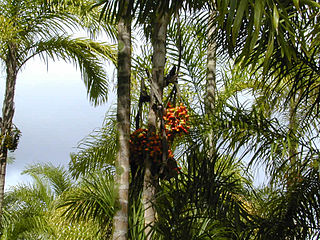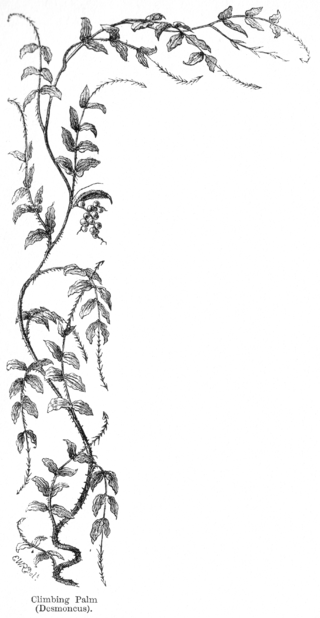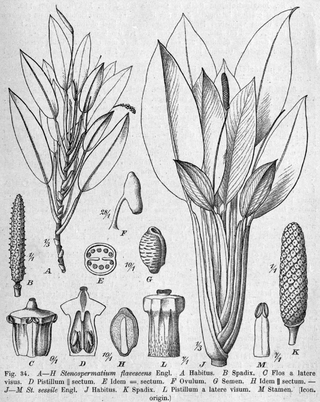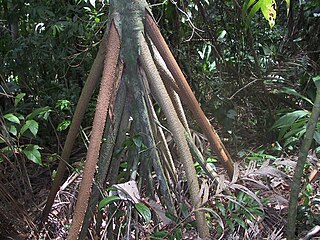
Bactris is a genus of spiny palms which are native to Mexico, South and Central America and the Caribbean. Most species are small trees about 2 m tall, but some are large trees while others are shrubs with subterranean stems. They have simple or pinnately compound leaves and yellow, orange, red or purple-black fruit. The genus is most closely related to several other spiny palms—Acrocomia, Aiphanes, Astrocaryum and Desmoncus. The fruit of several species is edible, most notably B. gasipaes, while others are used medicinally or for construction.
Dysopsis is a genus of plants in the family Euphorbiaceae, first described in 1858. It is the sole genus in subtribe Dysopsidinae. The genus is native to Costa Rica, Panama, South America, and the Juan Fernández Islands.
- Dysopsis glechomoides(A.Rich.) Müll.Arg. - Chile, S Argentina
- Dysopsis hirsuta(Müll.Arg.) Skottsb. - Juan Fernández Islands
- Dysopsis paucidentata(Müll.Arg.) Lozano & J.Murillo - Costa Rica, Panama, Colombia, Venezuela, Ecuador, Peru, Bolivia
Astrocasia is a plant genus of the family Phyllanthaceae first described as a genus in 1905. It is included in the subtribe Astrocasiinae. It is native to Mesoamerica, northern South America, and the western part of the West Indies. Plants are mostly dioecious, except for Astrocasia diegoae which is monoecious, and some individuals of A. neurocarpa and A. tremula.
- Astrocasia austinii(Standl.) G.L.Webster - Izabal
- Astrocasia diegoaeJ.Jiménez Ram. & Mart.Gord. - Guerrero
- Astrocasia jacobinensis(Müll.Arg.) G.L.Webster - Bahia, Bolivia
- Astrocasia neurocarpa(Müll.Arg.) I.M.Johnst. ex Standl. - Oaxaca, Querétaro, San Luis Potosí, Tamaulipas
- Astrocasia peltataStandl. - Costa Rica, Nayarit, Jalisco
- Astrocasia tremula (Griseb.) G.L.Webster - Mexico, Central America, West Indies, northern South America

Calyptrogyne ghiesbreghtiana, commonly called the coligallo palm, is an understory palm native to Central America and southern Mexico, where it grows in tropical rainforests.

Reinhardtia is a genus in the palm family native to the northern Neotropics. It is a primarily Central American genus with five species distributed between southern Mexico and the extreme north of Colombia, and one isolated species, Reinhardtia paiewonskiana in the southwest of the Dominican Republic.

Desmoncus is a genus of mostly climbing, spiny palms native to the Neotropics. The genus extends from Mexico in the north to Brazil and Bolivia in the south, with two species present in the southeastern Caribbean.

Oenocarpus is a genus of pinnate-leaved palms (Arecaceae) native to Trinidad, southern Central and tropical South America. With nine species and one natural hybrid, the genus is distributed from Costa Rica and Trinidad in the north to Brazil and Bolivia in the south.

Asterogyne is a genus of flowering plant in the family Arecaceae native to Central America and northern South America, with three of the five known species endemic to Venezuela.

Stenospermation is a genus of plant in family Araceae native to South America and Central America.

Polycycnis, abbreviated in horticultural trade as Pcn, is a genus of orchid, comprising 17 species found in Central America, and northern South America.

Sievekingia is a genus of orchid, comprising 20 species found in Central and South America, from Nicaragua east to the Guianas and south to Bolivia.

Socratea is a genus of five species of palms found in tropical Central America and South America.

Pholidostachys is a genus of palms found in Central America and northwestern South America.

Welfia is a genus of palms found in Central America and northwestern South America. Only two species are currently recognized: Welfia regia and Welfia alfredii.

Aechmea dactylina is a plant species in the genus Aechmea. This species is native to Costa Rica, Nicaragua, Panama, Colombia and Ecuador.

Cischweinfia is a genus of flowering plants from the orchid family, Orchidaceae. It was named after Harvard orchidologist Charles Schweinfurth. It has eleven currently recognized species, all native to Central America and northwestern South America.

Warrea is a genus of flowering plants from the orchid family, Orchidaceae. It has three known species, all native to Latin America.
Solenocentrum is a genus of flowering plants from the orchid family, Orchidaceae. It is native to southeastern Central America and northwestern South America, from Costa Rica to Bolivia.

Brachystele guayanensis is a species of orchid. It is native to southern Mexico, Central America, Trinidad & Tobago, and northern South America.
Chorigyne is a genus of plants first described as a genus in 1989. All the known species are native to Costa Rica and Panama.

















